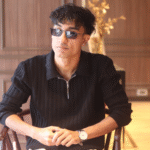Surendra Man Shakya and Priya Shakya: Carriers of a Sacred Legacy

In a rare and heartwarming encounter, we had the privilege of speaking with Surendra Man Shakya and his daughter Priya Shakya, two gifted artists devoted to the sacred tradition of paubha (thangka) painting in Nepal. What emerged from this conversation was not simply a discussion about art, but a window into a spiritual heritage passed down through generations.
A Heritage Rooted in Devotion: The Shakya Family Lineage
The Shakya family’s journey in paubha art spans over a century. It began with the late Ananda Muni Shakya, a revered figure whose masterful craftsmanship helped define the classical style of Nepali paubha painting. He laid the foundation for a lineage that views painting not just as creative work, but as an act of devotional offering, a spiritual discipline rooted in the Newar Buddhist tradition.
His son, the late Siddhi Muni Shakya, carried forward this legacy with quiet intensity. A deeply skilled and disciplined artist, Siddhi Muni was known for his profound understanding of iconography and traditional technique.One of his most remarkable undertakings was the creation of 108 Lokeshwars, a visionary project that reflected his deep devotion and meticulous artistry. Although initially hesitant to let his son follow the same path, concerned perhaps about the struggles of the artist’s path. He eventually recognized Surendra’s undeniable passion and potential becoming his teacher and mentor.
Together, Ananda and Siddhi Muni helped shape not only the family’s personal artistic tradition but have also contributed to the broader cultural identity of Nepali paubha painting.

Surendra Man Shakya: Painting as Worship
Surendra Man Shakya, now the third-generation torchbearer of this lineage, shared with us his daily rhythms and reflections. His day begins with a quiet reverence, visiting temples and meditating before picking up his brush. Even as health challenges have made long hours of painting difficult, his dedication remains unwavering.
As he spoke, his eyes glistened with emotion, and his voice carried the unmistakable excitement of someone who still lives and breathes his art. Thangka painting is not just an artistic practice for him, it is a form of spiritual devotion, a way of life.
Though age and health limit the intricate detail work he once poured into his paintings, the pride in his voice when describing the recognition his art has received was deeply moving. He finds comfort in knowing that the legacy he inherited from his father, Siddhi Muni Shakya, and grandfather, Ananda Muni Shakya, continues to thrive.
For Surendra, every paubha painting is not merely a piece of art, it is a sacred practice. It requires time, clarity, and deep internal stillness. Even when words fall short in describing the layers of detail and devotion in his past works, his eyes and voice speak volumes.
He also continues to teach and create, working closely with his brother-in-law, whom he has trained and who now assists him in the studio. Their collaborative efforts have resulted in awe-inspiring pieces that reflect both continuity and harmony.

Priya Shakya: Balancing Devotion and Motherhood
As the fourth generation of the Shakya lineage, Priya Shakya represents both the present and the future of this living tradition. A mother of twins, she balances the dual roles of artist and parent with grace and determination.
Trained under her father, Priya has assisted in several major works and absorbed not only the techniques of paubha painting but also its spiritual depth. For her, too, this art is an offering, a meditation, a path of faith. While motherhood presents real challenges especially during the intense phases of painting that demand total focus, Priya continues to carry forward the torch passed down through generations, drawing from the legacy of her father, grandfather and great-grandfather.
A Living Legacy
Surendra has also passed on his knowledge to his brother in law, Uttam Shrestha who now assists him in his studio. Their collaborative efforts have resulted in some truly stunning pieces, each brushstroke reflecting the harmony between traditional discipline and shared vision.
Despite decades in the field, Surendra’s enthusiasm is infectious. He speaks with the clarity of a master and the humility of a seeker. The layers of meaning in his older works, he says, cannot be fully expressed in words they must be felt, seen, meditated upon. And indeed, that truth was palpable in every story, every reflection and every moment of our conversation.
Through their words, we glimpsed not just a family tradition, but a sacred inheritance passed from grandfather to father to daughter. What they have preserved is not only a remarkable art form, but also a way of life, rooted in mindfulness, gratitude, and deep spiritual belief.
That sentiment encapsulates everything we felt during our time with the Shakyas. Their lives, their art, and their legacy are intertwined in a tapestry of reverence, resilience, and remarkable beauty. Their story is not just about preserving a tradition it’s about living it, breathing it, and passing it on with love.

An Invitation to Witness a Living Legacy
The Shakyas warmly invite everyone to experience their work firsthand at Gallery 108 preswnting “Kalãko vansha” in Durbarmarg, Kathmandu, where their paintings are currently on display. The exhibition highlights not only the recent works of Surendra and Priya but also offers a unique opportunity to immerse in the depth and sacredness of this artistic tradition.
A particularly special moment awaits from June 25 with the beginning of Phase II of the exhibition, where the gallery will showcase the 108 Lokeshwors, an extraordinary work by the late Siddhi Muni Shakya. This series, a spiritual and artistic milestone, is being shared with the public as a tribute to his lifelong devotion to the divine art of paubha.
And indeed, through every canvas, every expression, and every lineage story, this truth resonates. Their lives and legacy are a testament to how art can be an unbroken prayer, one that transcends generations, gently guiding each new artist like a thread through the tapestry of time.
Also read:
Project Kasero 2.0: Clean-Up Hike to Tarevir Marks World Environment Day
Mental Health Wellness: Why It Matters More Than Ever
Lemon Tree Premier Budhanilkantha Celebrates World Environment Day with a Week of Action
The Great Kabab Factory Pop-Up Arrives in Kathmandu: A Four-Day Culinary Extravaganza




























